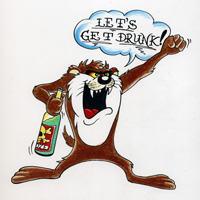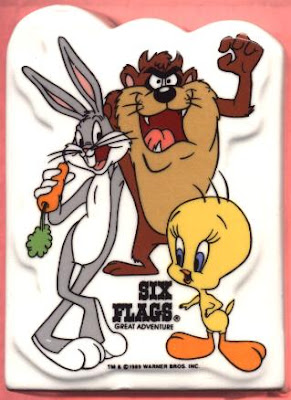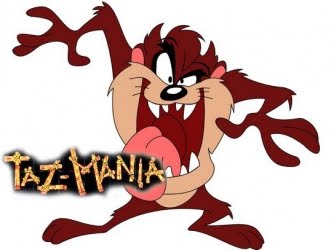
Tazmania Devil Funny
Animation can be used to inform, educate, advertise and express emotions just as live action can by using the same techniques; such as the use of colour, film language and sound. The NSPCC advert by Russell Brooke on television is a good example of how animation can be more effective than live action. There is no limit to how much a situation or an action can be exaggerated but still remain to be convincing. In the advert if a real child was being thrown around it would be extremely controversial and although it is actually what is going on behind closed doors it would be too much for some people to watch. The animated character is created in a way that portrays the child in a way that will get the message across. This example shows how valuable a tool animation really is, that it is not just a media form to entertain young children. It is also a good vehicle to show that cartoon violence can be used to a positive end.

Tazmania Devil Funny
On the other hand cartoon violence can be quite aggressive and graphic like the 'Grand Theft Auto' video games series and some Manga features involve a lot of violence and gore but created in a quite realistic way, not suitable for a young audience where as cartoons adapted from Marvel comics such as 'Spiderman' and the 'X-Men' are primarily orientated around fighting but done in a less bloody way. The fight sequences involve a few kicks and punches and a superhuman power is used which doesn't normally inflict much gory, physical damage on the opponent, instead the loser is left with a scratch or two on their face with a trickle of blood oozing from their mouth.

Tazmania Devil Funny
The fights, realistic as they may be, are not overly graphic, otherwise they would have to be shown after the watershed, but they are descriptive enough to express what is going on within the story. Most important of all is the fact that good always triumphs over evil in these cartoons. This does not justify the fighting but neither does it encourage it. Fisticuffs in a live action feature is always more violent than fighting in cartoons as it involves real people who can get hurt whereas cartoon characters feel nothing, making the fighting seem less realistic than a live action fight sequence.

Tazmania Devil Funny
The belief that animation is a media form directed mainly at children is not necessarily true, but in some situations this can be used to the advantage of the producers. A good example of this is the recent 'DairyLea' commercials, created in a 3D Stop Motion technique it shows some talking cows encouraging children to eat their product, not just on its own, but with mashed potato. The advert shows that 'DairyLea' can be mixed with other foods and the format is more memorable to children (the talking cows), therefore they are more likely to ask their parents to buy them some. Another good example of animation aimed at children is the 'Green Cross Code' (stop, look and listen).

Tazmania Devil Funny
This informative commercial shows hedgehogs crossing a road in an animated and musical way, encouraging children to do as they do and they will be safe. This format was chosen so children will remember how to safely cross the road as told by singing hedgehogs-which would not have been possible in real life through a live action format. The advert offers an interesting, memorable alternative to mundane, forgettable, live action instructions.

Tazmania Devil Funny
Since animation is made popular by children, (for example, the phenomenon of the 'Pokemon' series) there are a number of ways producers can capitalise on the launch and success of a series. The producers see many ways of making more money from a successful cartoon because they know that children will do anything to get their hands on elements of merchandise, for example the 'Pokemon' battle cards. Merchandise does not just stop at playing cards though; there is stationary, cutlery, bags, toys, clothing, books, posters and video games.

Tazmania Devil Funny
It is this side of animation that results in adults distancing themselves from the genre because of the fact that the cartoon series is blatantly aimed at children and so this is enough to put them off watching. Formerly the animation format adopted a biased approach aimed solely at a younger audience. In the early days animation it was fascinating concept, a drawing that was moving. Since it was a new concept people of all ages took an interest.

Tazmania Devil Funny
Now the omnipresence of the format through the years that people find it entertaining up to a point in their lives then just stop watching animation as they get older, then when they have kids of their own the viewing process starts again. It is because of this misconception of the format and its association with youngsters that successful attempts have been made to break this mould. Since some adults have an interest in animation specific titles and series' have been aimed at an adult specific audience, these include the '2DTV' series, some 'Manga' titles, Comedy Central's 'South Park', 'The Simpsons', 'Futurama' and the Japanese 'Hen-Tai'. To conclude this point, John Serpentelli writes in an article, that "The connection between children and animation seems simple enough.

Tazmania Devil Funny
To a child, anything is possible and the same is true for animation." The animation format is also able to inadvertently teach children about the artistic side of animation, as John Serpentelli says, "Since animation is an art form that can involve almost all other art forms and children can directly encounter the art world in an unfiltered manner."

Tazmania Devil Funny
A recent comeback of 80's animation has shown resurgence in popularity of classics such as 'The Clangers', 'Bagpuss' and 'The Magic Roundabout'. Adults who viewed these animations when they were younger tune in to see these classics of their day, and their children join in. Some adults are required to watch animated videos in the workplace, on issues of safety. Having to watch, follow and understand irritatingly obvious and drab pieces of animation could be enough to put some adults off the format, believing the genre is as bad as the video they had to view.

Tazmania Devil Funny
This also shows that animation can be as realistic and informative as live action, but simpler to understand, where as on the other hand cartoons aimed at children, however unrealistic, sometimes incorporate a moral or advice at the end of the episode, in an effort to teach the youngsters watching what is right and what is wrong. The reason being for this is that if children see their favourite cartoon character doing something or telling them to do something then they might be encouraged to do as they say. This just shows that if done correctly animations can be as entertaining as they are informative or educational for a range of audiences.

Tazmania Devil Funny
Within video games the games character which the player controls is brought to life by using animation. The character would be lifeless if it was not animated and so the use of animation is crucial. The incorporation of animation does not stop there as FMV's (Full Motion Videos) are also used to tell a story within a video game. This is a good example of how animation can make the impossible possible; by giving inanimate objects and characters life.

Tazmania Devil Funny
Animation is a priceless tool for all types of media when the impossible is required to become possible. For example, there are no limits to action or comedy in an animated feature, and animation provides these additional effects in a live action feature, effects that would not be possible to recreate safely or due to the limitations of a human actor. An example of such effects that are used in the movies is in the film 'The Mask' starring Jim Carrey to allow the face of the mask wearer to become very rubbery, distorted and very flexible. Animation allows the actor's face to become very pliable, allowing things to happen to it that are not humanly possible. The animation techniques incorporated within films are normally used in the special effects areas.

Tazmania Devil Funny
This has been true as far back as movies such as 'Sinbad' where Ray Harryhausen's 3D stop motion monsters were revolutionary in their day and opened up a whole new unchartered area of the world of film. As painstaking as the monsters were to bring to life the end results were astounding and very effective, adding a whole new atmosphere and dynamic to a movie. Examples of the use of this technique in films are: 'Robocop' and the ED-209 machine and the stone gargoyles in the film 'Ghostbusters' to name but two of many. The use of 3D stop motion within a live action movie did not get left behind though in favour of the technologically advanced effects that computer graphics offered. Animation can have a unique manipulative effect on objects as it can turn normally innocent lifeless objects into dark sinister beings In contrast, animation can turn toys into what children want them to be if they could come to life, as for example in Disney's 'Toy Story'. Again here is that element of target audience, depending upon what age group is being targeted animation can be as dark or as cheerful as required.

Tazmania Devil Funny
In the world today it is becoming increasingly clear how popular and widespread animation has become. The production of an animated feature or series is carried out in an almost identical process to that of a live action feature or series. For instance, both formats need a good story, as this will hold the attention of the audience. The story is then required to be storyboarded, just as a live action feature is. Correct use of film language is essential in both formats whether to create an action, suspense or an emotional sequence. Characters are incredibly important to both formats. The audience need to like, relate to or in the 'bad guys' case, hate them. If the cast lack the attributes then the audience just will not care what happens to the characters, will not feel involved in the feature and lose interest.

Tazmania Devil Funny
Since a live action feature casts real life and famous actors to attract the audiences, animation is also taking advantage of this element but because the animated features involve computer generated characters, not real life actors it is just as important to give that character a personality, to convince the audience that a computer generated character can have just the same effect on them as a real life star. This is why Disney features are increasingly using big-name Hollywood actors and actresses within them to create believable and likable characters, as well as the fact that recognizable voice talent brings in bigger audiences just as live action films with well known stars attract bigger audiences. An example of this is 'Toy Story' where actors such as Tom Hanks, who provides the voice for 'Woody', have been involved with the feature and this in turn makes the genre more popular as it will encourage more people to see the film if they can recognize a voice or the film is associated with successful and famous actors.

Tazmania Devil Funny
There are many important similarities in the process of making a live-action feature and producing an animated feature. For example whether the character is animated or is a real person, they both have to convincingly portray emotions, express body language and provide an effective dialogue and realistic expressions. As well as the characters, aspects such as film language are important in both features to allow a situation to be suspenseful, emotional or to create an effective action sequence. As well as the visual aspect, the audio, too, has to be able to convince an audience and to add atmosphere to a scene. These are common similarities between producing an animated feature and making a live action feature. For example there is a much broader scope to what can be achieved in an animated feature over a live action movie, as live action tends to have a realistic edge since the actors are real people and props are real and so on An animated feature can be realistic or unrealistic and the situations and characters are in the hands of the animators. In live action however there are limits to what human actors can do. Also there is no need for stuntmen or stunt doubles in an animated feature, and animated characters are more flexible than real life actors since they don't question working hours and make no wage demands! As technology has shown there could be no need for real actors soon as computer generated characters are becoming more and more realistic, one only needs to view recent animated features such as 'Final Fantasy: The Spirits Within'. Even though the media forms of animation and live actions differ, the bottom line is best said by Professor Nina Martin, "The history of animation is in tandem with live action film. You cannot understand the history of live action narrative film without including animation".

Tazmania Devil Funny
Despite there being many comparisons between live action film and animation, essentially both are the same, since"...the definition of cinema is rooted in the ability of its basic technology to present a series of representational images (and perhaps sounds) that create the illusion of movement where of course there is nothing but still images flashing at a prescribed speed." An extract from 'The Cinema Book 2nd Edition'. This emphasises the fact that both live action and animated films are created in the same ways but the only difference being the way in which they are expressed, live action as live action and animation as a primarily drawn medium but both forms consist of multiple images to create a sense of movement within the piece. To break this down even further, animation has been described by some critics as "Cinema at its purest" also from 'The Cinema Book 2nd Edition'. "Since animation creates movement where there was never any 'real' motion at the pre-filmic stage".
As more people become aware of how animation can be used and what it can do, it is increasingly being incorporated within live action films. For example it can be used to recreate dangerous stunts without putting anyone's life at risk by using the 'Green Screen' technique, most recently seen it the box office hit film 'Spiderman' where the character is seen swinging high up from building to building, without actually having to in real life. An alternative use of animation is when something impossible for a human actor to do is done via animation, for example in the movie 'The Mask'.
It is not just recently that movie crossovers have become popular. However they were also used in features such as 'Mary Poppins', where the human actors were sharing a world with animated creatures that interacted with each other. Since then films such as 'Who Framed Roger Rabbit', 'Space Jam' and 'Rocky and Bullwinkle' have each used this genre crossover successfully. The purest form of this technique is 'direct on film', where animation is created on film reels, specifically one medium is created on another medium. An extract from 'The Cinema Book 2nd Edition' explains that, "Such animation makes the fullest use of the medium as it foregrounds the entire process of making, projecting, and finally perceiving movement where none ever existed."
The advancements in computer technology have enabled the animation format to go a step further, creating frighteningly realistic films and film effects. Paul Wells shows in an article from 'Art and Animation', "Live action and 'animation' are once more converging in ways that make one indistinguishable from the other, and servicing a new orthodoxy in 'realism' in many feature films like 'Jurassic Park' and 'Twister'." As the genre becomes ever more popular and more widely recognized as 'Disney' is a household name, just as Steven Spielberg is known for making great live action movies, Disney makes great animated features, as well as Warner Brothers, Hanna-Barbera and more recently Matt Groening. As a tool, animation is becoming used more often as it becomes more flexible as animation becomes more technologically advanced and ever more ground-breaking.
Such an example is the use of animation within video games which enables realistic visuals to be used in a computer generated, fictional world. 'The Getaway' on the PlayStation 2 shows how games are becoming more like interactive movies. The setting, London, is a real location recreated in painstaking detail. Vehicles have been created to resemble them in real life and the game uses real actors that have been created to look like their real life counterparts. The actors were motion captured and scripts were recorded, the same processes which an animated feature is produced. They were then used in the game to make the characters more convincing and believable. The game shows how animation can be pushed to its technological limits, proving that animation can be as real or as unrealistic as it needs to be. The game offers such an element of realism that the actors involved have actually been offered roles in popular television shows, for example the Joe Rice who plays the police officer in 'The Getaway' has recently been in 'EastEnders', showing that the live action and animation cross over are becoming more popular. Advancements in computer capability and its technology have enabled animation to have even more uses than ever before, but as Sean Wagstaff says from his Book 'Animation on the Web', "There's no question that the art of 3D has not yet fully evolved, and in the hands of far too many users, it is still a science more than an art."
Post Title
→Tazmania Devil Wallpaper Funny
Post URL
→http://tazmaniagalleries.blogspot.com/2011/10/tazmania-devil-wallpaper-funny.html
Visit Tazmania Galleries for Daily Updated TAZMANIA










































